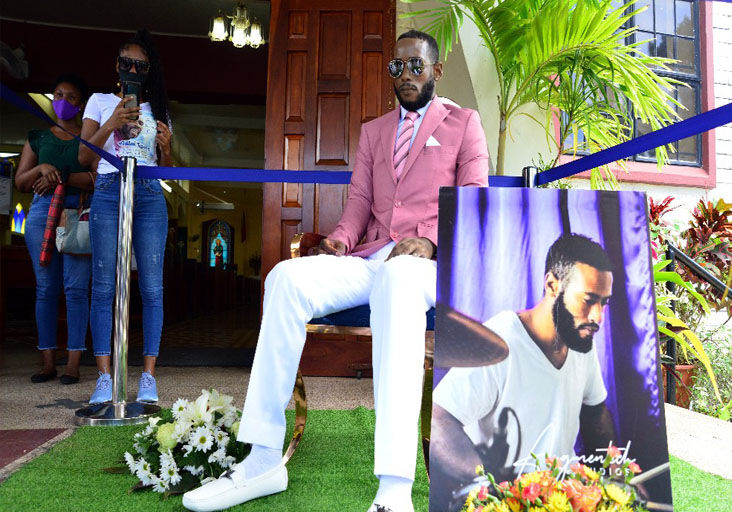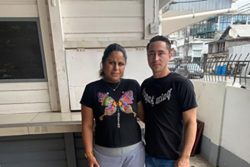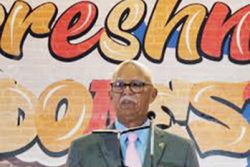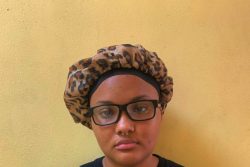(Trinidad Express) FOLLOWING last week’s controversial “extreme embalming” funeral where the seated body of Che Lewis arrived via procession, the Catholic Archdiocese last Friday reminded of the “dignity” of the body and said parishes will now have to request details ahead of services.
An article in last Friday’s Catholic News quoted parish priests Fr Roger Paponette and Fr Martin Sirju, who said the locally unprecedented ceremony was “offensive” according to the principles of community faith.
According to the Catholic News, “Now that extreme embalming is here, parishes will have to request details from persons requesting funerals.”
“This now is going to be part of the questioning, you can no longer take things for granted that people are following simple societal rules and sensibilities,” Paponette, parish priest for San Rafael, was quoted as saying.

The faith deems the body to be the “temple of the Holy Spirit and as such is to be treated with utmost respect, even after death” and while last week’s controversial funeral for Lewis, a shooting victim, was not expressly forbidden by doctrine, the Church has frowned upon it.
“You are treating the body as if there is no seriousness in death,” Paponette said.
The article also noted The Code of Canon Law, which “does not speak directly to how the body is exhibited at the funeral” but according to principles of the faith, the body of a deceased is treated with a certain respect.
Paponette said another underlying principle is community and “we are not individuals living in isolation”.
“Church is about a community of believers, there are certain things that are offensive,” he said.
The article stated that, “The public display of a deceased man being transported at the back of a hearse converted to accommodate the body in a seated position generated much commentary Wednesday on social media.”
It also said: “The seated body of Che Lewis was taken from the funeral home located in Belmont to the St John the Evangelist RC Church, Diego Martin. Lewis and his father Adlay Lewis were killed at their Bagatelle, Diego Martin, home on November 14. The body of the elder Lewis was in a casket and inside the church while his son was positioned near the entrance. A lay minister presided at the service within the church and the usual rituals took place with the sprinkling of holy water and incensing also done for Lewis (C).”
“Extreme embalming” was brought to Trinidad and Tobago by Dennie’s Funeral Home, where the motto is “Every life is unique therefore, every funeral should be unique”.
The three-year-old funeral home is managed by Cochese Tyler Dennie and is based in Belmont. As noted by the Catholic News, “extreme embalming” entails a body being preserved with embalming fluid and positioned, as has been done overseas, with persons dressed up and displayed as they had requested before death.
Dignity after death
The Catholic News stated that, “In the Catholic faith the body is deemed to be the temple of the Holy Spirit and as such is to be treated with utmost respect, even after death.”
“Although the Canon Law and the CCC do not speak directly to how the body is exhibited at the funeral,” Paponette, who is trained in Canon Law stated, adding that “the norms are always general so will not provide every detail e.g. the type of casket, etc.”
According to the Catholic News, Paponette said, “It goes down to what is called principal values and what it protects is the dignity of the human person.”
He said the principle of considering the other, “is not so much what you do is not forbidden, [and] there is nothing written anywhere about it…You have also to take into consideration the impact it has on those around you and if it is offensive”.
Persons should not be guided solely by the thinking they were “in the right”, Paponette said.
Fr Paponette suggested that guidelines may have to be created as there are persons who are “unchurched” and with the influence of what may be popular, situations are being created which the Church did not encounter before.
“We have assumed for far too long that people know, and the thing is they don’t. They don’t get it from their homes, they don’t get it from the school, from the community. It is going to be hard. We have to find ways to help people understand,” he stated, adding that it can’t be assumed people were “brought up with a sense of respect”.
Facing death and grieving
Vicar General Fr Martin Sirju identified two aspects of the funeral which struck him, the Catholic News stated.
“An apparent inability to face the horror of departure, whether from a social or psychological point of view. Death is a disruptive thing,” Sirju said.
He added that death is “unavoidably morbid and people do not like to confront the fact that they must die”.
In death, the body returns to the elements, “literally returns to the dust from which you came”.
However, the horror and finality of death can’t be avoided, he said and that “grieving is human” and has a place in society.
“Sorrow and grief are given to us by God as something we have to go through and when we go through it in the proper way, we become more human not less so,” Sirju said.
Canon Law: Embalming not wrong
While the Code and the Catechism make no reference to how a body is presented at the church, it is customary “for bodies to be in coffins even those that are embalmed”, the Catholic News stated.
“Embalming, involving the removal of fluids from the body and replacing them with chemical solutions to delay decomposition, is not against Church rules. It is not unusual since most funerals do not take place immediately after death and vigils were traditionally held before the funeral Mass,” the News said.









